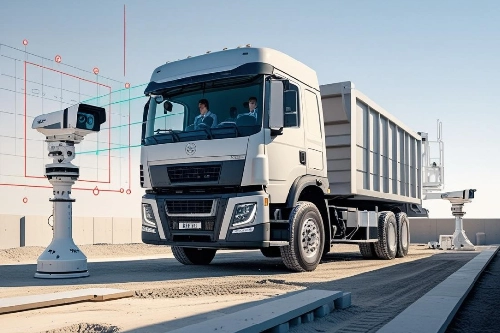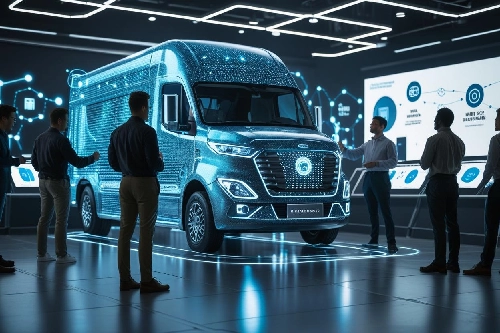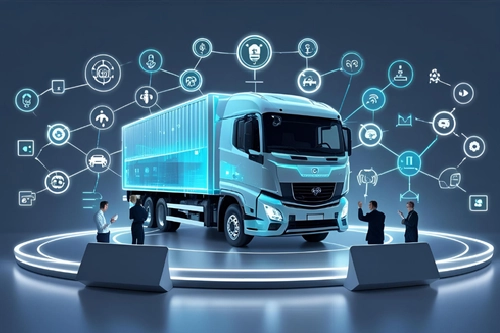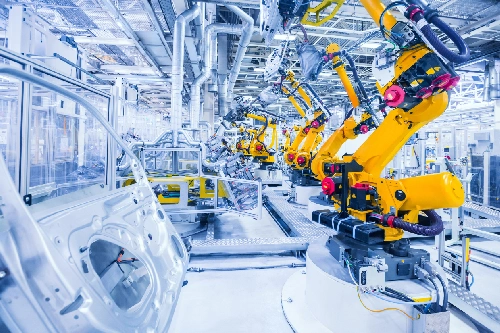Executive summary

A tier-one automotive supplier discovered something unexpected while investigating field failures in their latest ADAS-equipped mining trucks. The root cause involved neither software bugs nor sensor malfunctions. Instead, microscopic variations in chassis welding angles during production were throwing off camera calibration by fractions of a degree. These tiny deviations, invisible during factory quality checks, created blind spots that only manifested months later under specific lighting conditions in remote mining sites. While this example illustrates a broader industry challenge, what changed how they thought about vehicle development entirely was discovering that manufacturing precision affected more than structural integrity. The same precision determined the intelligence capabilities of every system downstream.
This scenario reveals a fundamental shift that most engineering leaders are only beginning to recognize. The boundary between manufacturing excellence and operational intelligence has disappeared. Robotics in manufacturing systems directly influences autonomous mobility reliability. Digital twins in engineering determine predictive maintenance effectiveness in operational environments. Computer vision in vehicles that guide assembly line quality checks evolves into hazard detection systems for mining operations. The companies mastering this integration go beyond building better vehicles. They are redefining what intelligent commercial vehicle engineering means.
The global commercial vehicle market is projected to experience significant growth through 2032, with industry analysts forecasting substantial expansion driven by increasing demand for intelligent vehicle systems. Yet this growth demands unprecedented integration between manufacturing DNA and operational intelligence. Traditional approaches that separate production and performance engineering create vulnerabilities that compound over time. Meeting tomorrow’s demands requires unified technology platforms where factory automation capabilities scale into field applications, creating intelligent commercial vehicles from their first weld joint through decades of operational service.
Commercial vehicles face distinct challenges that span from manufacturing precision to field adaptability. This article examines how computer vision in vehicles, digital twins in engineering, and robotics in manufacturing create unified solutions that bridge factory and operational environments, transforming both on-highway and off-highway vehicles throughout their lifecycle. Success emerges when these technologies function as integrated platforms rather than isolated capabilities.
The digital mandate for commercial vehicles

Commercial vehicle engineering has reached a point where relying solely on traditional mechanical expertise puts companies at a competitive disadvantage. The evidence lies in warranty claims data that reveals an uncomfortable truth. Most field failures in intelligent commercial vehicles trace back to integration issues that originated during manufacturing. Rather than component failures, these are system interaction problems that emerge only under real-world operational stress. Engineering teams now face demands that seemed impossible five years ago. A single mining haul truck must process sensor data from hundreds of sources, communicate with infrastructure systems across multiple protocols, and make autonomous decisions while maintaining the uptime levels that determine project profitability. The complexity compounds when considering that the same vehicle platform must achieve emissions compliance, meet varying autonomous operation requirements across different countries, and adapt to electrification timelines. These timelines shift based on regional infrastructure development.
The companies succeeding in this environment discovered something counterintuitive. Precision manufacturing experience from industries like aerospace often proves more valuable for intelligent vehicle development than traditional automotive expertise. Intelligent vehicles require the tight tolerances and rigorous validation processes that aerospace manufacturers already understand, while traditional automotive approaches lack the design foundation for the integration complexity that autonomous systems demand. This realization explains why some of the most successful commercial vehicle automation projects come from companies with industrial automation backgrounds rather than traditional automotive suppliers.
Machine vision enabling intelligence across harsh realities

Machine vision in commercial vehicles faces challenges that consumer automotive engineers rarely encounter. A construction site presents dramatically different lighting conditions within a single work shift, from pre-dawn artificial lighting to direct sunlight reflecting off metal structures. Traditional ADAS systems struggle in industrial environments because they are designed for highway predictability. Working environments present chaotic conditions that change constantly, creating challenges that these systems cannot handle effectively.
ADAS for commercial vehicles, especially off-road, requires fundamentally different approaches. Lane detection algorithms must recognize boundaries that exist only as GPS coordinates on mining haul roads. Driver monitoring systems analyze fatigue patterns in operators working extended shifts in vibration-intensive environments. Blind spot elimination becomes critical for vehicles with an extended turning radius navigating spaces designed for passenger cars. Traffic sign recognition must interpret temporary signage in multiple languages while filtering out the construction markers that proliferate around work zones.
Vision-based condition monitoring delivers breakthrough results by preventing catastrophic failures that destroy project economics. Real-time tire condition assessment detects sidewall damage that indicates potential blowouts on expensive commercial vehicle tires. Cargo monitoring systems identify load shifts that could cause vehicle instability before drivers feel changes in handling. Trailer connectivity verification prevents jackknife accidents that occur when electrical connections fail during coupling operations. Mining operations deploy machine learning algorithms that analyze video feeds to detect subtle equipment behavior changes that precede mechanical failures.
Edge-deployable AI models solve the connectivity problem that affects cloud-dependent systems in remote operations. These systems process thermal imaging data in real-time to detect equipment overheating in environments where cellular connectivity becomes unreliable. Continual learning capabilities adapt to operational patterns specific to individual work sites, learning that certain vehicle movements indicate normal operations in one location but equipment malfunction in another. Over-the-air (OTA) update capabilities ensure continuous improvement while maintaining cybersecurity standards that protect high-value industrial operations.
Digital twins accelerating development through virtual validation
Digital twin technology solves the validation bottleneck that traditionally extends commercial vehicle development cycles significantly. Physical testing of heavy-duty vehicles requires specialized facilities, extreme weather simulation, and durability testing that costs substantial resources while providing limited scenario coverage. Virtual-first development approaches compress these timelines while testing scenarios too dangerous or expensive for physical validation. Real-time simulation capabilities enable engineers to model vehicle behavior under conditions that would destroy physical prototypes. Battery pack performance simulation for electric mining trucks predicts thermal behavior during continuous operation in extreme ambient temperatures. These conditions would require extensive field testing to validate physically. Vehicle behavior modeling captures complex interactions between heavy payloads, chassis flex, and suspension systems across terrain types that span from highway to steep mining slopes.
Manufacturing integration through digital twins creates the shift-left approach that prevents costly redesigns after production begins. Factory-level digital twins identify bottlenecks in assembly sequences before production equipment arrives, preventing the delays that typically occur when heavy vehicle assembly lines discover ergonomic or sequencing problems. Hardware-in-the-loop testing validates control system behavior under electromagnetic interference conditions common in industrial environments, eliminating field issues that emerge when systems interact with high-power electrical equipment.
Immersive engineering applications transform global collaboration for engineering teams managing products across multiple continents. Augmented reality (AR) applications provide guided repair procedures that overlay instructions directly onto complex hydraulic systems, enabling technicians in remote locations to perform maintenance procedures that previously required factory-trained specialists. Service cycles complete 30 to 40 percent faster while training errors decrease by 50 percent. Virtual reality (VR) applications enable engineering teams in different time zones to collaborate on three-dimensional vehicle system designs, reducing design iteration cycles substantially.
Robotics integration is solving manufacturing and operational challenges

The robotics revolution in commercial vehicles addresses critical challenges that threaten industry growth, including the shortage of skilled technicians capable of manufacturing and maintaining intelligent heavy-duty vehicles. Autonomous mobile robots (AMRs) handle in-plant logistics and quality inspection using the same navigation algorithms that guide autonomous vehicles through work sites. The shared technology platform reduces development costs while accelerating technology maturation through cross-domain validation. Manufacturing robotics achieves precision levels that human operators cannot match consistently. Vision-guided robotic arms perform chassis welding with repeatability tolerances measured in fractions of millimeters. Such precision determines sensor mounting accuracy when the vehicle begins autonomous operations. Component placement systems position electronic control units with the mechanical stability required for systems that must function reliably through millions of vibration cycles in industrial environments.
Operational robotics applications demonstrate how the same technology platforms serve both manufacturing efficiency and field operations. Robotic roadside inspection systems perform automated vehicle compliance checks using computer vision algorithms similar to those employed for factory quality assurance. Automated refueling and charging systems eliminate the safety risks associated with human operators working around high-voltage electrical systems in remote locations. Precision docking and coupling systems for trailer operations solve skill shortage problems in logistics operations while reducing accident rates that occur during complex backing maneuvers.
Testing automation represents the convergence where robotics, software, and artificial intelligence create validation systems that exceed human capabilities. Robotic testing platforms execute durability test sequences with the consistency required to validate systems across extensive operational cycles. AI-driven analysis identifies performance degradation patterns that human operators miss, enabling predictive failure detection that prevents warranty claims. Cross-domain learning allows insights from manufacturing operations to improve field maintenance procedures, while operational data refines factory processes.
Quest Global’s silicon-to-systems-to-cloud framework
Commercial vehicle engineering complexity demands partners who understand that intelligent vehicles require integration expertise spanning from semiconductor selection to cloud analytics platforms. Quest Global’s approach addresses the reality that modern commercial vehicles contain substantial software complexity while requiring the durability standards of industrial equipment. AI and machine learning model development focuses on edge vision and robotics control applications where cloud connectivity cannot be assumed. These optimized algorithms function reliably in resource-constrained embedded systems while maintaining real-time performance requirements under electromagnetic interference conditions common in industrial environments. Ruggedization expertise ensures sensor reliability in environments where temperature variations are extreme and vibration levels would destroy consumer electronics components. Precise sensor calibration methodologies maintain accuracy across operational conditions that span from arctic mining operations to equatorial construction sites.
AR- and VR-enabled field solutions transform maintenance operations for equipment operating in remote locations where expert technicians cannot travel cost-effectively. Immersive technologies provide guided repair procedures that enable local technicians to perform complex diagnostics and repairs with expert oversight delivered remotely. Full-stack product lifecycle support extends from initial architecture design through manufacturing integration and ongoing after-sales support, ensuring system performance throughout operational lifecycles that span decades.
Cross-domain delivery capabilities spanning automotive, industrial automation, and aerospace create technology cross-pollination that accelerates innovation. Aerospace precision manufacturing expertise adapts to autonomous commercial vehicle requirements. Industrial automation solutions scale to mining and construction equipment applications. Robotic HMI testing capabilities combine multiple technologies into unified validation systems that address commercial vehicle development complexity through integrated approaches impossible with traditional engineering methods.
Integrated platforms enabling breakthrough performance
Commercial vehicle manufacturers discovered that breakthrough results require abandoning the incremental improvement mindset that guided traditional automotive development. The companies achieving significant reductions in development time and substantial improvements in field reliability understand that machine vision, digital twins, and robotics deliver exponential value when engineered as unified systems rather than separate solutions. This integration creates competitive advantages that extend beyond individual vehicle performance metrics. Manufacturing teams reduce validation cycles by testing complete vehicle systems through digital twins before committing to physical prototypes, preventing costly redesigns that typically occur when integration issues surface late in development programs. Quality improvements in factory automation translate directly into field reliability because the same sensor calibration and validation processes serve both manufacturing control and operational intelligence applications.
Engineering teams mastering integrated platforms rapidly adapt solutions across vehicle types and operational environments. The computer vision system that guides robotic welding in truck assembly adapts to hazard detection for autonomous mining operations. Digital twin models that optimize factory workflows scale to predict maintenance requirements for vehicles operating in remote locations. Such platform integration enables rapid deployment of intelligent capabilities across diverse applications while maintaining reliability standards required for commercial operations.
Manufacturing excellence driving operational intelligence
The commercial vehicle industry’s transformation reveals a counterintuitive truth. Operational intelligence success depends more on manufacturing DNA than on software sophistication alone. Production systems that achieve consistent quality through machine vision and robotics create the foundation for vehicles that maintain intelligent capabilities throughout operational lifecycles measured in decades rather than years. Digital twins that optimize manufacturing workflows evolve into predictive maintenance platforms that prevent catastrophic failures that destroy project economics. Manufacturing-first methodology transforms vehicle development by ensuring that every design decision considers both production feasibility and long-term operational performance. The integration extends to supply chain management, where manufacturing partners must meet precision standards that exceed traditional automotive requirements.
Engineering partnerships succeeding in this environment bridge the gap between advanced research and practical implementation while providing global delivery capabilities required for multinational commercial vehicle operations. The convergence of machine vision, digital twins, and robotics represents the emergence of intelligent commercial vehicles that adapt and improve from their first manufacturing operations through decades of operational service. Such convergence fundamentally changes what commercial vehicle engineering can achieve.
Quest Global helps commercial vehicle manufacturers achieve operational efficiency by reducing on-ground complexity through integrated engineering approaches. Our cross-domain expertise spanning automotive, industrial automation, and aerospace enables clients to accelerate development cycles while improving reliability from factory to field. Complex operational challenges become manageable engineering solutions that scale across diverse commercial vehicle applications.


